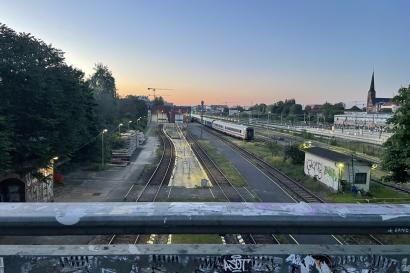One of the biggest advantages of studying in Berlin is its comprehensive and interconnected public transit system, called the BVG. This was a major reason for my choice to study in Berlin, I think the U.S. can learn a lot from the transit here.
Since the system is so large and provides so many options, it can be quite overwhelming to navigate at first. Thankfully, IES Abroad has taken the first step to simplifying it by providing monthly passes within the AB zone to use all the transit modes.This pass, given monthly, gives you access to all BVG transit (including the S-Bahn) within the A and B zones, which encompass the inner city. If you want to travel to the C zone (including the airport and Potsdam) you’ll have to purchase an additional pass. This can be purchased in a station from a ticket machine, or through the BVG Fahrinfo app, either by ride or by 24-hour ticket.
One key difference between the BVG and most American transit is the lack of turnstiles. Much of European transit runs on the honor system, simply validate your ticket (or carry your monthly pass) and board. Ticket validation boxes can be found on trams and buses, or in U-Bahn and S-Bahn stations. Validating your tickets, or carrying your monthly pass, is a MUST and not following the rules can result in a 60 Euro fine.
To travel using BVG, both google and apple maps offer accurate information regarding arrivals and routes. If you want more information on arrivals at individual stations, I would recommend downloading the BVG Fahrinfo app, which can also be used to buy tickets.
With the BVG there are 4 main transportation options, trams, buses, the U-Bahn and the S-Bahn. Below I give a quick overview of each option:
Tram: Trams are an above-ground railed system that uses the same street as cars to travel.
Locations: Trams will get you short distances mostly within the innermost part of the city, however some extend to the southeast edge of Berlin as well.
Finding a stop: stops are marked with a green and yellow H on a pole, or identified by the schedule hanging above a shelter. To find a stop from a U-Bahn or S-Bahn station follow the arrows with the tram symbols.
Identifying the lines: There are 22 lines in total, each shown with a red ‘M’ and a number (i.e. M5, M2). Each line goes in 2 directions, identify which side of the street you should be on by the direction indicated on the arrivals schedule
Frequency: Trams usually come every 10-15 minutes
To board/disembark: press the button to open the doors. You can press the “stop” button to request a stop, but typically they’ll stop at every station anyways. For riders that cannot step up into the tram, press the button with a stroller on it to call the driver to lower a ramp. Don’t forget to validate your ticket once on board!
Buses:
Locations: Bus routes in Berlin cover the whole city and can take you varying distances
Finding a stop: Bus stop signs have a green H on a yellow background, on the pole list the routes that stop there listed with the purple bus symbol
Identifying the routes: Buses are labeled with a number on a purple background, make sure you’re on the right side of the street when you board!
Frequency: Buses run every 20-30 minutes typically
To board/disembark: If needed, validate your ticket on board the bus. Press the stop button to request a stop, doors will open automatically.
U-Bahn: the U-Bahn is Berlin's subway system, although some lines run above ground
Locations: the U-Bahn system is incredibly comprehensive and can take you most places in the city
Finding a stop: look for stairs with a blue sign above them. The sign will have an U on it as well as the station name
Identifying the routes: there are 9 U-Bahn lines numbered 1-9. The lines are marked with U and the number (i.e. U2, U5). Once on the platform for the correct route number, use the hanging arrival schedule to find which side your train will be on
Frequency: the U-Bahn arrives about every 5 minutes (or less!)
To board/disembark: older trains will have a handle on the door that must be pushed out in order to open doors, newer trains have a button to open
S-Bahn: The S-Bahn is technically a part of Deutsche Bahn rather than BVG, however your monthly pass and most BVG tickets will also work on S-Bahn. It works like a regional rail, but also has many stops within Berlin.
Locations: The S-Bahn can take you between major stations in the city, but works best for traveling longer distances around the city
Finding a stop: S-Bahn stations are marked with an S in a green circle
Identifying the routes: There are many S-Bahn routes through and around Berlin, they are marked with an S and a number (i.e. S1, S2)
Frequency: S-Bahn lines run at different frequencies depending on the line, typically 5-10 minute intervals for routes within the city, 20 minute for longer routes, and 30 minutes for routes at night
To board/disembark: Validate your ticket in the machines on the platform, press the button to open the doors.







Sylvia Waechter
Guten tag! My name is Sylvia, I'm an Urban Studies student at the University of Illinois - Chicago and I'll be studying in Berlin, Germany this semester! I'm a total public transportation nerd and love to write reviews of different transit systems that I ride on. Follow along as I explore Berlin, travel around Europe, and continue my education as an 'Urbanist in training'.













